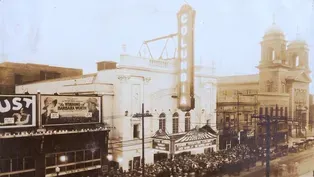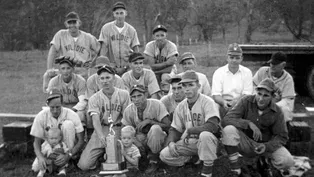
James Caufield and Frank Shook
Clip: Season 30 Episode 12 | 6m 2sVideo has Closed Captions
20th Century Louisville Photographers.
Two photographers who captured scenes of Louisville during the twentieth century using developing technology.
Problems with Closed Captions? Closed Captioning Feedback
Problems with Closed Captions? Closed Captioning Feedback
Kentucky Life is a local public television program presented by KET
You give every Kentuckian the opportunity to explore new ideas and new worlds through KET. Visit the Kentucky Life website.

James Caufield and Frank Shook
Clip: Season 30 Episode 12 | 6m 2sVideo has Closed Captions
Two photographers who captured scenes of Louisville during the twentieth century using developing technology.
Problems with Closed Captions? Closed Captioning Feedback
How to Watch Kentucky Life
Kentucky Life is available to stream on pbs.org and the free PBS App, available on iPhone, Apple TV, Android TV, Android smartphones, Amazon Fire TV, Amazon Fire Tablet, Roku, Samsung Smart TV, and Vizio.
Providing Support for PBS.org
Learn Moreabout PBS online sponsorshipPhotography is a practice that, like many, has changed and evolved with constantly improving technology.
It became widespread in popularity during the early half of the 20th century, which is the setting for our next story.
James Caulfield and Frank W. Shook came together in the 1900s to form a photography company, appropriately called Caulfield and Shook.
Throughout their lives, they captured thousands upon thousands of images of Louisville's businesses, events, and landscapes.
They were masters of their craft, and thanks to their work, we're now able to observe how Kentucky's largest city has changed through time.
[music playing] Caulfield and Shook probably met just as different photographers in the downtown core of Louisville.
There were so many at that time, and their studios weren't that far from each other.
James N. Caulfield was a photographer here in Louisville who began his career in the late 1800s.
He started a studio with his brother-in-law, Alvin Gordon, and was one of maybe 20 different photo studios in the downtown core of Louisville.
Caulfield and his brother-in-law had a disagreement, so Frank Shook bought out Gordon's share of the business, and they started their own firm in 1903 called Caulfield and Shook.
And their motto was, we photograph anything, day or night.
So, that's literally represented in the collection of photographs that we have.
They photographed people, events, businesses, buildings, scenery, locations, landscapes, you name it.
It's represented in the collection.
Most of Caulfield and Shook's income came from their stock photography.
These photos have ended up in the University of Louisville's collection and have become a great resource in showing the changes the city experienced during the 20th century.
Together, Caulfield and Shook documented key events and places throughout Louisville's history, like Camp Zachary Taylor, a World War I training camp, where they took photographs of troops and activities.
Another event that they photographed was the 1937 flood.
And in one story, Frank Shook talks about how the mayor had contacted them to be ready to take photographs for documentation and identification of victims of the flood, but it turned out that there weren't any.
So, they went around and photographed the scenes and the flooded streets and buildings.
And that's, in fact, when they lost a large portion of their stock photography collection.
Frank Shook talked about spending the night before the waters really came up high, moving all of -- or as much as he could, the stock collection from the basement upstairs.
And what he couldn't move has been lost.
So, a lot of their early work is not in the collection.
In 1924, Caulfield and Shook became the official photographers for the Kentucky Derby, a position held by the firm until its closing in 1978.
Frank Shook talked about employing a number of freelance photographers, hiring photographers from other studios just to document the Derby, because it took so many of them, sometimes up to 18 photographers stationed around Churchill Downs to photograph what was going on Derby Day.
One of my favorite photographs by Caulfield and Shook is a portrait of seven young African American boys standing outside the Prentice School property, holding saws and other tools, and next to a wood fence that presumably they had just built.
Another one of my favorite photographs is a simple street scene that was taken at the intersection of 25th and Main Streets in 1930.
And I've gone to Google Street View to see what's still there, how does it compare?
And the buildings are still there, and you can see exactly the same scene that was shot in 1930, and really it's a lovely example of seeing the changes that Louisville's gone through.
So, Caulfield and Shook sold their shares of the business to two photographers that worked for them, Ned Tanzel and Dick Duncan, in 1960.
And it was in 1968 when those two men decided to donate a large portion of the photographic files to the University of Louisville Photographic Archives.
Caulfield and Shook is one of our most accessed collections, so not only by students in the university community, but we're open to the public.
And anytime somebody is looking for pictures of their house or their street or their school or their business, it's often the Caulfield and Shook collection that they're finding those photographs in.
Elizabeth says the Caulfield and Shook collection is around 80 linear feet, which translates to about 47,000 nitrate negatives and more than 230,000 acetate negatives and prints.
Processing of the collection began when it arrived at the University of Louisville in the late 1960s and continues to this day.
I think everybody loves the photographs of Caulfield and Shook today because they show Louisville at a time at which nobody around today remembers, and it gives us a really good glimpse into the past of the city that we live in.
I hope that people who are looking at the Caulfield and Shook photographs learn something new whenever they look at these photographs.
I know that I do.
I often teach students to look closely at photographs, look closer than you're used to looking, like take a magnifying glass and look at the details that you're not usually paying attention to.
How is life different now in Louisville than it was when it was photographed by Caulfield and Shook?
Look at the street signs, look at the buildings and the advertisements, and look at the traffic lights.
Everything was different, and it's all documented in these photographs.
In Search of the Round-Leaved Sundew
Video has Closed Captions
The Round-Leaved Sundew, a unique plant recently discovered in Kentucky. (5m 26s)
Video has Closed Captions
Paducah has a surprisingly long and dynamic history with the movies. (6m 14s)
Video has Closed Captions
The Tobacco League was a baseball popular league between World War II and the Korean War. (6m 46s)
Providing Support for PBS.org
Learn Moreabout PBS online sponsorshipKentucky Life is a local public television program presented by KET
You give every Kentuckian the opportunity to explore new ideas and new worlds through KET. Visit the Kentucky Life website.














